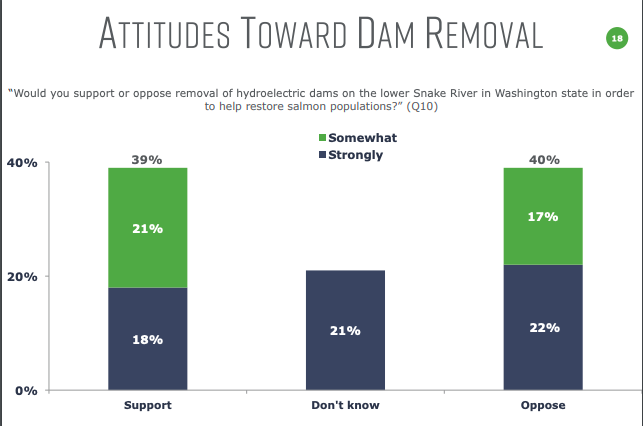forum
library
tutorial
contact

Energy, Salmon, Economy:
Accord on Snake River Dams Possible
by Martha Kongsgaard
Seattle Times, December 19, 2019
|
the film forum library tutorial contact |

|
Energy, Salmon, Economy:
by Martha Kongsgaard
|
In 2019, fish returns in the Columbia-Snake Basin have some of the lowest counts on record.
 I was born into a family of grape growers and cattle ranchers. I was taught to honor hard work and keep a strong environmental ethic. Here in the Northwest, I believe it's our responsibility to create a future that works for both people and salmon.
I was born into a family of grape growers and cattle ranchers. I was taught to honor hard work and keep a strong environmental ethic. Here in the Northwest, I believe it's our responsibility to create a future that works for both people and salmon.
That's why Gov. Jay Inslee's Lower Snake River Dams Stakeholder Engagement Report gives me hope.
The draft report is the result of interviews with more than 100 stakeholders; more than 3,500 people have responded to an online survey. But the most groundbreaking component of the report hinges on four words: "Opportunities to Increase Understanding."
We have the opportunity, today, to think together in new ways about how we manage the Snake River -- the biggest tributary to the Columbia River and vital to agriculture, salmon and the families that live in its watershed.
For decades, we've looked at four dams on the lower Snake from exclusive vantages: necessary for barges and power or lethal for salmon. While the report makes no recommendations on removing the dams, it highlights ways neighbors across the Northwest can come together to look at new solutions that take into account all our communities.
And we do need new solutions.
Dams hinder passage for endangered salmon making their way between Idaho and the Pacific, where orca feed on them.
Over the past 20 years, more than $17 billion in funding for fish restoration in the Columbia River basin -- along with five federal restoration plans courts have ruled inadequate -- has failed to restore salmon and steelhead populations. In 2019, fish returns in the Columbia-Snake Basin have some of the lowest counts on record. Chinook, sockeye and steelhead returns all fell below already-poor expectations of fisheries managers. On the Snake River, sockeye returns were just 6% of the 10-year average by late August. The Washington Department of Fish & Wildlife closed parts of the Columbia to salmon and steelhead fishing because of dismal returns; Idaho closed much of its fishing as well.
And, of course, the orcas that feed on these fish are dying. Only 73 remain in the Salish Sea.
Meanwhile, the Bonneville Power Administration (BPA), which markets electricity generated by the dams, is facing financial challenges. Its onetime reliable customer, California, is creating its own clean power now, and wind and solar generation is driving down the cost of electricity all over.
For decades, BPA has provided our region cheap, carbon-free power. Our families and businesses are counting on it to continue doing so.
We believe we can problem-solve these related issues -- energy, salmon and economy -- together.
Which brings us to the "opportunities to increase understanding" in the governor's report.
Some of the questions it poses: What are our goals for salmon recovery, and what role does a free-flowing Snake play in achieving them? How do alternatives to these dams compare for providing affordable, reliable power? What are the costs -- and who pays -- for new water and transportation infrastructure if dams are removed?
Some people are already thinking about these questions.
A recent study by ECONorthwest found that breaching the dams and subsequent upgrades to transportation and irrigation systems for farmers, along with growth in tourism and recreation from a restored river and fish populations, would generate more than $8 billion in net economic benefit.
That doesn't include additional opportunities from the build-out of new energy infrastructure to replace power from the dams, or the benefits of fish and river restoration to communities upstream in Idaho and downstream on the lower Columbia and along the coast.
It's possible to imagine solving these decades-old challenges in new ways, with new partners, that take all our communities into consideration.
The governor's report is not yet final. Everyone who cares about these issues can share their thoughts in the Lower Snake River Dam online survey. Public workshops on the draft are being held in January in Clarkston, Vancouver and the Tri-Cities.
Along with these discussions, we need political leadership at the state and national levels that understands people are eager to tackle these issues creatively, inclusively and soon.
In other words, we need leaders who want to help us solve each other's problems.
Commercial fishers looking out for farmers. Grain transporters looking out for tribes. All of us looking out for our common values: prosperity and growth, a love of this unique place in the country, and respect for our neighbors with whom we share it.
learn more on topics covered in the film
see the video
read the script
learn the songs
discussion forum
